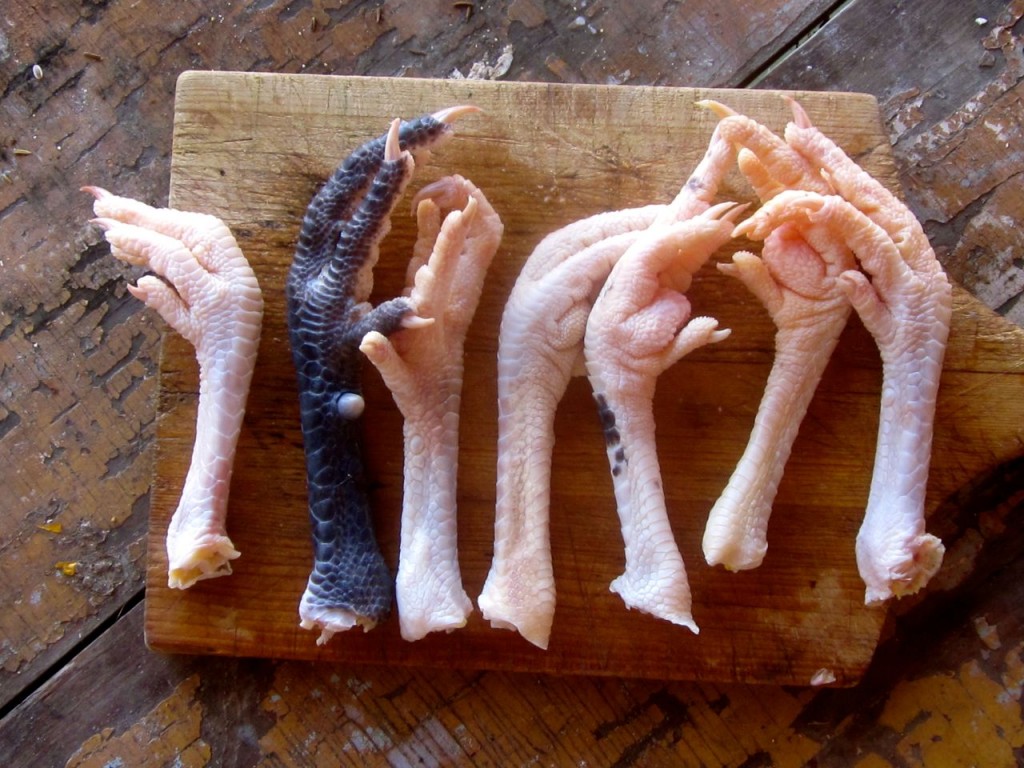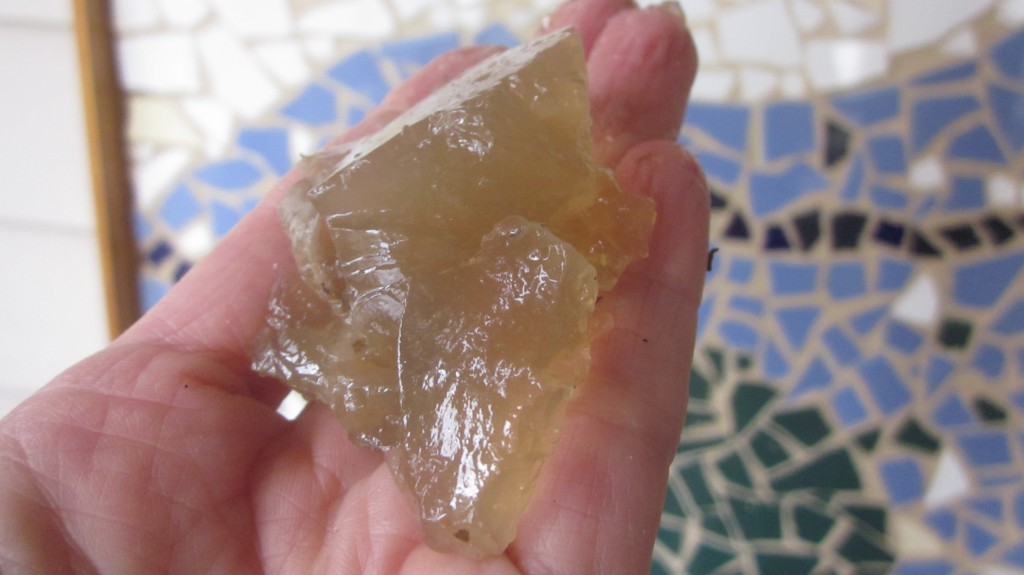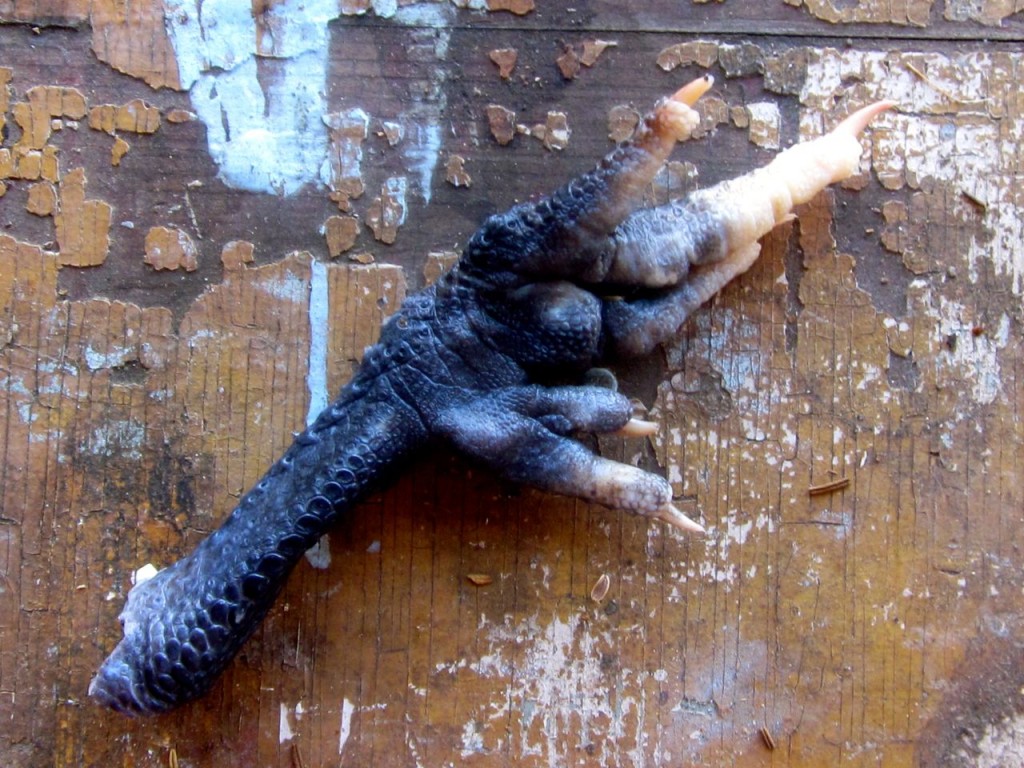How to make excellent stock out of chicken feet!
I’m going to show you how easy it is to make stock out of chicken feet. It’s not gross at all, I promise!

I’ve got two big bags of chicken feet in my freezer. Oops, no, now I can say that I’ve got one big bag of chicken feet in my freezer, and I do say it–with a sense of accomplishment, too, you can be quite sure. With spring bearing down on us (one of these days, mark my words, it will come, at least the calendar says so) and the promise of raising more food in the garden and the orchard and the chicken yard (if it ever, ever rains again, that is) I’ve been digging into the freezer, using up (stew hens, frozen sweet corn, stew beef, precious sour cherries) and tossing out (those bags of shredded zucchini that I didn’t use before they became full of iciness) (the chickens aren’t choosy about freezer burn, bless them) so there’ll be room in the freezer for this year’s fruits of our labor.
Guess what? We’re thinking about getting a couple of pigs. I’m saying that very, very quietly, because I don’t know if we’ll get to them this year, but Bryan at least is willing to talk with me about it. We have lots and lots of spring-variety jobs to do before we get to “Build a pig fence” on our list. Wait. I don’t think it’s there yet. Hmmm.
Well. It’s not on the list, but probably (probably!) it is in Bryan’s heart, because he loves me and he also (bless him) loves good bacon. And good fun. And an adventure, now and then–not too often, though, mind you. And raising our own pigs, I’m quite sure, would result in all three of those things. Don’t you agree? Remember the day the pigs came to visit? That was an adventure. And it was fun. But, no bacon.

“What . . . ?? What are you staring at? We’re not doing anything. . . “
Also I’ll raise meat chickens again and of course I’ve planted a bajillion heirloom tomato plants (NOT exaggerating on the number, at least, not by much) with lovely names like Pink Bumblebee, Blue Beauty, Tess’s Land Race Currant, Dr. Wyche’s Yellow, Berkeley Tie Die, True Black Brandywine. . . what dreams those names conjure up! I’m determined to make more salsa (I’ll share my recipe with you this year, I promise!) because running out of jars of salsa shortly after Christmas is not cool. Not cool.
So many plans. So much to look forward to. But I really do need to get the pantry and freezer cleaned out. And thus, back to the chicken feet.
Every fall when I take my old hens and my meat chickens to the butcher, I ask the amiable guys there to bag up the feet for me. The man with the apron who meets me at the back door is very respectful of my request, but I can hear the workers in the back guffawing and glancing out at me. “That’s the woman who always wants to keep the feet–ha–what a rube! What a throwback!”
Yes, that would be me.
And then when we get home, I bag up my year’s worth of meat chickens and old stewing hens and pack them securely away into the freezer, with that big funny bag of feet. I tell you, I feel like an authentic Prairie Woman, with a bag of chicken feet in my freezer, ya’all. Every time I open the freezer, there it sits. Full of promise. Full of collagen. Full of glucosamine chondroitin (which people pay big bucks for), you know. Full of dead chicken feet.
That bag of chicken feet stays there for awhile, too, as you may suspect. I know that it’ll take a bit of work to process the feet into broth, and also I know that there is just a touch of an “ick” factor involved, so I put it off. Until my stomach turns me toward those feet.
I’ve been having a few stomach problems–nothing serious, just some hints and groanings which indicate that all is not well in that hidden place–which have made me think about those bags of chicken feet. I’m a great maker and drinker of bone broth, you know, and I usually try to toss a couple of chicken feet into the pot when I’m making it, but I’ve also read that chicken feet broth is absolutely the best source of the obscure nutrients that make a good stock so nourishing: glucosamine chondroitin, collagen and trace minerals, not to mention calcium. All that stuff is so good for your gut. And your joints, as a matter of fact.
So, my troublesome stomach urged me to dig out a bag of chicken feet and get to work. My problem knee applauded, as well. Sometimes troublesome stomachs and problem knees have to take matters into their own hands. So to speak.

Once I got over my squeamishness, I had to admit that these feet–scrubbed and cleaned–were actually quite beautiful. Don’t you agree?
Sometimes minor health problems will force you to take a little bit better care of yourself . . . and sometimes that means you have to–at last–face the bags of frozen chicken feet.
I’ll bet that line has never been written in a blog post ever before. I’d bet money on it, if I were a betting person. 🙂
To be honest: at first when I started working with the feet, I did feel a bit squeamish. A part of the recipe I was following indicated that I had to chop off the toenails. I guess they can add an off-taste to the broth. Whatever. The toenails on the bigger feet were practically impossible to chop off with a knife, so I switched to my bypass pruner (thoroughly washed, of course) and it worked like a charm. However. I felt a bit savage in chopping off the toenails with a pruner, at the kitchen counter. They went flying about, the toenails, that is, with bits of the toes attached. I had to scrabble around and find each one, lest they end up in somebody’s piece of cake, or something. Amalia’s cup of tea. 🙂 Talk about off-putting.
Then, a strange thing happened. I was all alone in the kitchen, soberly performing this grisly task, classical music quietly playing on the radio, my troublesome stomach urging me on, my problem knee saying a silent prayer of thanks, when I heard a little voice.
“Ouch. That hurts.” I jumped. Then I realized that little Mack had come into the back room and was standing in there, out of my sight. I started breathing again. “What hurts?” I called in to him. “My finger. My finger hurts,” he said in a small voice. Geez. What are the odds?
A little strange, the timing, wouldn’t you say?
Anyway. Little Mack joined me in the kitchen, and watched me for a moment. “What are you doing to those chicken feet?” He asked with a shudder and a grimace, though he’s not particularly squeamish about anything. The lad will dissect any stinking thing he can find, it’s true. “Cutting the toenails off,” I said, through clenched teeth (it’s not an easy task, Gentle Readers). “WHY are you doing that, and MOM, the poor chickens!”

“Honey,” I reminded him. “The chickens, of course, feel nothing at this point.” I didn’t remind him that we had probably eaten most of the chickens by now, the chickens who had once been attached to these very feet.” “I know,” he said, “but still-–!”
The squeamishness and the nail-chopping and everything is so worth it, because chicken feet broth is lovely and clear and gels beautifully, and has a very nice taste, as well. Every broth geek knows that the pinnacle of broth-making success is a beautiful gel, like so:

Absolutely gorgeous!
And that gel–rich in collagen and nutrients–is what I knew would soothe my anxious stomach. And my creaky knee. And probably other areas of my body which were needing attention, as well. Not to get too personal. (Cough.)
Here’s how to make your own chicken feet stock, if you have a big bag of chicken feet in your freezer, or if you can find some to buy (local chicken farmers are a good source, as are butchers who butcher chickens, or Asian and Mexican markets–I’ve even seen them at the Wal-Mart in a nearby town that has a big Mexican population). It takes a bit of time to make this, but not overwhelmingly much.
- 3 lbs chicken feet, scrubbed very well
- 1 big onion, chopped
- 1 large leek, cleaned and thinly sliced
- 4 ribs celery, chopped
- 3 carrots, chopped
- 1 Tb whole peppercorns
- 1 handful of parsley, chopped
- 2 bay leaves
- 1/2 cup white wine
- Cold water to cover all the above
- First, prepare the feet: if there is a yellow skin still attached, boil for 5 minutes, and peel the skin off. Chop off toenails with big knife (use care!) or pruners.
- Combine feet and all other ingredients, covering entire mess with water, and bring to a boil.
- Immediately decrease the heat to medium-low, cover, and simmer for 8 to 12 hours, adding water as necessary to keep the feet immersed. Skim away any scum that might rise to the top. Give that to your dog. It would add an off-taste to your broth, but your dog will love it. Speaking from experience. My dog’s, not mine. 🙂
- Strain the broth, discarding the solid stuff, and pour into freezer containers and freeze for up to 6 months, if you don’t use it right away. (Discard the layer of yellow fat that hardens on the surface of the broth.)
That’s it! Your family (and your stomach) (and your joints) will love you if you make this for them. It’s so delicious, and is a great addition to soups and stews, or is just good for broth-sipping, too. Bottoms up!

See, this one had an extra little toe!


None of us have ever questioned the fact that you are a true authentic Prairie Woman. And you are right about the chicken feet in the Mexican markets. Actually, we have them (the butchers) cut off the tips of the toes if need be, but usually when you order some chicken feet, they chop the toes off with their butcher knives before handing them to you. Word of warning, when the day does come that my wife and I stop by your place do not say anything about having chicken feet in the freeze for fear she will ask you to make a fresh chicken soup right on the spot. After the soup is finished she will eat whatever is not boiled away inside the feet. She does like chicken feet. As for me, I’ll stick to drinking the broth and eating the carrots.
Next time I make chicken feet broth, Chef, we can time it so you and your wife can stop by, and your wife can chew away at all those feet. I hated to dump them in the trash, but after working with them I really didn’t have the appetite to eat them . . .
Love this post it’s so interesting x
Thanks Pixie!
This looks grim, but I bet it tastes amazing!
I’m sure it tastes great, but I can’t wrap my head around eating it. Must be my protected upbringing.
Scott,
Those feet are so full of goodness that they make wonderful broth! You don’t have to actually eat the feet.
I just love your writing and your posts! I learn something new each time.
May I ask why you take the chickens to the butcher instead of doing it yourself?
Thanks Cheryl. The reason I take them to the butcher: um. I usually have 30+ chickens to butcher each fall, and I decided years ago that I’d rather pay the butcher (I think it runs me $1.75 per chicken) and take a short road trip with my daughter to take them there, and then to sit and have a cup of coffee and afterwards, to bring them home in freezer bags, then to do it myself. 🙂 I know. I’m a wimp. But I think there is a bit of wisdom in choosing which jobs you can delegate, or you’d rather pay somebody else to do for you. It’s hard enough for me (emotionally) to choose which hens need to go in the freezer, much less to actually Do The Deed that will put the poor old dears there.
Good stuff, Amy. I used to enjoy chewing on the feet ( after cooking, of course)
Dad, aren’t the feet mostly skin and bone, though? After simmering them for 12 hours, there didn’t seem to be much left. AND they were still pretty rubbery.
I once ate chicken feet served in a dim sum restaurant in Washington DC. Waitstaff was circulating with little plates of various dim sum, and I thought they were something else. Sur-prise! (they weren’t my favorite – yes, I did try them – too many years ago, don’t remember how they were prepared.) In the five years we raised chickens in Arkansas, we never even thought about using the feet. Too bad there was no Internet back then.
Alana,
I did feel just a twinge of guilt at dumping those chicken feet into the trash, post-stock, but just a twinge.
I can’t wait to do this. I have read that you can scald the feet and the outer skin will peel off, with the toenail. I also read that to get all the goodies out of feet they can be simmered for up to 24 hours!! Please correct me of I’m wrong. I just can’t wait to try this.
Monte,
Where I get my chickens processed, they dip the chickens (and the feet) in water to scald, so the feet come out without the yellow outer skin (phew!) but the nails are still VERY FIRMLY attached. I think you’ll still have to chop ’em off. And also, you can put a tablespoon of apple cider vinegar in with the feet to help leach out minerals (that’s a common ingredient in bone broth) and I’m sure they can be simmered for 24 hours. I’ve done that before, easily, with the crock-pot! Have fun! Hope it turns out well for you!
I’m not going to lie, the chicken’s feet freaked me out a little bit! I bet the broth is full of great nutrients though!
Hello, from my sick bed. I have ventured up this morning and put on some chicken broth in the hope that it might get rid of this ridiculous flu. I love the idea of using chicken feet. I need to go find some, maybe our local butcher will have some.
Oh Anita-Clare, winter is almost over, it’s definitely time to GET WELL! I hope you find those chicken feet and make some nourishing broth–STAT!
Pingback: End of the Hoop House Season Soup, tra-laaa! - vomitingchicken.com
Glad you touched on the scalding and skinning of the feet before freezing, LOL
We’ll be butchering 25 Freedom Rangers soon and I’m planning to arm-wrestle some of the other co-op members for some of the feet. I think we’ll also clip off the toenails before bagging them. The good news is that none of the others seem to know what a treasure the gizzards are.
We’re doing them ourselves because the local USDA approved processor wants $6 per bird. I don’t really begrudge them because they had tremendous expense to build their facility but we’re not doing them for commercial re-sale. I recruited anybody who was interested in purchasing some of them, and we’ll be doing an assembly-line processing, with each member helping and seeing it’s done humanely and with proper handling. I’ve also purchased some shrink-wrap bags for them.
$6 per bird, my goodness, that’s expensive Dianna!! I’d learn how to do it myself for that much. Actually we do some of our own butchering, but when we have a big batch (like our meat chooks) I take them to a small processor in a town about an hour away. They charge about $1.80 per bird. I figure it’s worth the drive!
Oh dear. I never bother to cut off the “toenails.” I just wash the whole thing and throw it in 🙁
Mary Beth, when I’m in a rush, I don’t do that step, either. Guilty secret.
Could this be done in an electric pressure cooker to save time?
John, I would say: try it! I’ve never tried this with the electric pressure cooker. My gut says (harhar) that the long slow cooking would be absolutely the best way (it would leach, I believe, the most collagen out of the bones) but my head says that the pressure cooker would be nearly as effective. Maybe try it, then refrigerate the broth and see if it jellies up?
I’ve done this with the electric pressure cooker AND the stovetop pressure cooker for years. I don’t clip the claws. It turns out incredibly delicious and full of gelatin. Any chicken stock (or bone broth, if you will) that I make always includes a pound or two of chicken feet. Incredibly rich and nourishing.
Yes, thank you, Mike!
I love chicken feet broth that mom used to make and now I have twice. I now have 2 large containers of gel from the broth in the frig. None of the recipes or tips tell you how much of the gel to add to your soup or stew. For instance, I now just made chicken soup from a whole chicken with herbs. I have the cut onions and carrots on the side. I covered the chicken with water and let cook down a little and then added a container of regular store bought chicken broth. That brought it back up to covering the chicken. I let it cool down and removed the chicken to remove the bones. My question: how much of my homemade chicken feet gel do I add to make the soup broth I just made nice and rich? Thank you.
Diane,
It’s not easy to tell you the answer to this, since I don’t really know the volume of your broth. But do what I do–just experiment a little and see how you like it best. I’d add a handful (hmm, maybe a half-cup?) and heat it up, and see how you like it. If it’s not rich enough, add more. Start small and inch your way up until you get the perfect amount. Voila! You’re a recipe developer!